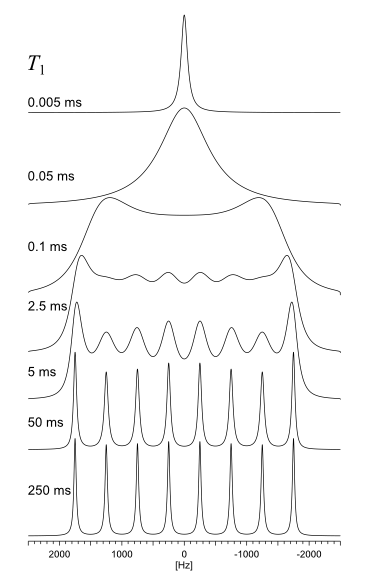[Uni Tübingen] - [Mat.-Nat. Fakultät] - [Fachbereich Chemie] - [Anorg. Chemie] - [Klaus Eichele] - [Software] - [WSolids1] - Quadrupolar relaxation

|
WSOLIDS1:
|
Description

Background
This model is actually intended for the calculation of the solution spectrum of a spin-1/2 nucleus coupled to a quadrupolar nucleus where the spin-lattice relaxation of the quadrupolar nucleus affects the spectrum of the spin-1/2 nucleus. This is illustrated here for the following spin system: 31P coupled to 51V (I = 7/2), with J(51V,31P) = 500 Hz and the 51V spin-lattice relaxation times T1 indicated in the figure. At intermediate T1's, the apparent unequal intensities within the non-binomial octet are the result of the different life times of the associated 51V spin states, causing different line widths and hence different peak heights (but equal integrals).
Examples
The SVG images shown below were produced using the following tools: my own SpecPlot to plot the spectra, Platon or Ortep 3 for Windows to plot the molecular structures from X-ray data, and Inkscape to compose the picture.
| H-1 NMR spectrum of iPr2HN-BH3 (solution): this example uses two isotopologues, with indirect spin-spin coupling to B-11 and B-10 and demonstrates how to use the tie feature to relate the B-10 parameters to those of B-11: J(X,B-10) = 0.334861 × J(X,B-11) T1Q(B-10) = 1.531164 × T1Q(B-11) Although the experimental spectrum does not reveal the presence of B-10 directly - the four-line pattern only points towards B-11 - inclusion of the second isotopologue with B-10 is required to "push up" the central two lines. The agreement between experimental and calculated spectrum is excellent then! The molecular structure is from calculations reported in this paper: E. M. Leitao, N. E. Stubbs, A. P. M. Robertson, H. Helten, R. J. Cox, G. C. Lloyd-Jones, I. Manners, J. Am. Chem. Soc. 2012, 134, 16805; DOI: 10.1021/ja307247g |
[ Anorg. Chemie ] | [ Go Home ] | webm@ster | last modified: 22.03.2024

